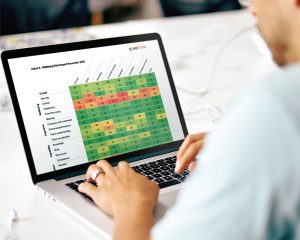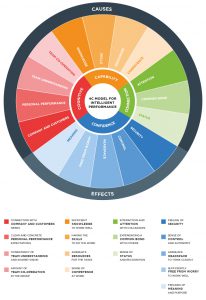One-on-one meetings have the potential to deliver huge value. However, more often than not managers end up going in blind. Without a comprehensive one-on-one meeting template your employees’ needs and vulnerabilities could get overlooked and you’ll waste valuable time, energy and resources.
Regular meetings are essential to ensure both parties will avoid shock or surprise during annual performance reviews. However, the additional challenge of one-on-ones taking place over video chat also make employees less likely to be forthcoming about their difficulties. If you don’t design the meeting well you can also damage relationships with your people.
So how can managers navigate this? Our specialist one-on-one meeting template will walk you through the dos and don’ts of a productive session.
How often should we meet?

By comparison, your longer-serving team members might only require bi-weekly or monthly meetings. Depending on how different responsibilities are split across your team you’ll probably have to adjust the length of each meeting, too. Setting aside an hour for each employee is long enough to avoid surface level conversations and short enough to avoid attention drifting. Just make sure its consistent by creating a recurring event in both calendars.
Create a safe, open and honest environment
Building a relationship with your employees is critical to develop a strong team where everyone feels engaged, supported and valued. You could begin by sharing something that you’ve personally found challenging at work, praising them for a recent good performance, or getting to know them on a more individual level.
The pandemic has affected all of us, and now more than ever it is important to ask employees about their life outside of work. For some, it has brought a nicer work-life balance. For others, being shut away for a year has taken a heavy toll on their wellbeing.
Start your one-on-one meeting by understanding how they are coping outside of work to get a good indication of any additional stressors that your people might need support with. This also shows your employees that you care about their wellbeing beyond 5pm.
Remembering that your employees have lives outside of your organisation and giving them the space to talk about this will ensure they feel confident to bring their whole selves to work.
Decide your one-on-one meeting aims
One-on-one meetings are often broad, all encompassing catch-ups to see “how you’re doing,” and measure employee progress against goals and KPIs. Leave space in your one-on-one meeting template by giving your employees some flexibility to choose what topics they want to cover. This will create much more productive conversations and indicates what your employee thinks is most important in their role.
Letting your employees guide the meeting will ensure they are a much more active, honest contributor, and the discussion meets their underlying, subconscious needs.
However, you must keep the conversation focused. Ensure you’re giving helpful feedback, praise where it’s due, diagnosing problems and helping with practical solutions that enable staff to achieve personal growth and greater productivity.
What topics should your one-on-one meeting template cover?
If your current one-on-one meeting template isn’t having the right impact then you might be asking the wrong questions. Come to each meeting fully equipped to ask the right questions at the right time supported by the right information about each team member.
Think about what you should be measuring. WeThrive’s 4C model is a useful one-on-one meeting template because it breaks down the four key areas that affect how we think, feel and operate at work. This includes:
- Cognitive questions: addressing what people have in their heads
- Capability questions: your employees’ perception on support and resources
- Connection questions: the subconscious drivers of how staff feel and interact with colleagues
- Confidence questions: the conscious feelings about work, otherwise known as our wellbeing indicators
Consider asking questions that address these key areas. For example, if your employees feel disconnected and isolated from their team since working from home then their performance can quickly suffer. Therefore, understanding how your employees feel about their connection to the company and customers or whether they feel they have a strong common bond with their colleagues are important factors that directly affect bottom-line business performance.
To address these factors you could ask “how much of the time are you really clear about how the company and its customers benefit from your work?” or “how often do you feel a common bond with others in the team, sharing ideas and team spirit?” These questions give you the opportunity to dig a little deeper and discover where your employees need support.
However, it isn’t always easy for your employees to put into words exactly what might be triggering lower motivation or reduced personal performance. Subconscious factors like our sense of status within the organisation can be difficult to verbalise and awkward to mention to managers.
Want to walk into every one-on-one meeting with a clear understanding of your employees needs?
Designing and holding effective individual meetings are time-consuming tasks but the right one-to-one meeting template can make understanding your employees needs simple. Using a tool such as an employee experience survey can help to tease out the underlying causes of poor engagement or wellbeing at work.
WeThrive offers the best solution to this challenge. WeThrive’s 4C model gives managers the tools they need to understand what is going on in the heads of their people and provides quick, easy to follow guidance to help remove obstacles to engagement, wellbeing and productivity.
Instead of spending your one-on-one meeting trying to understand why your employee’s productivity has fallen, simply consult your dynamic WeThrive dashboard. If they’re not getting enough headspace to think clearly then you can cut to the chase in your one-on-one meeting and follow our simple action plan for improved engagement.
With WeThrive’s free employee engagement and wellbeing survival kit you’ll get all the tools you need to identify and resolve vulnerabilities and opportunities in your organisation.
Free employee engagement and wellbeing survival kit

The survival kit takes just 7 days to uncover the specific vulnerabilities among your people, and it doesn’t stop there. We’ll break down the data for you and tell you precisely what actions you should take to see quick engagement and wellbeing improvements across your organisation.
Four simple steps to get your Engagement and Wellbeing Survival Kit and improve your one-on-one meeting template
- Create your free WeThrive account by signing up here (no credit card info required)
- Send out your survey in a few clicks – sit back and relax for 7 days
- We’ll send you the analysis for your organisation (and a few extra goodies)
- Work through our recommendations to help your people thrive!
About WeThrive
Employee Engagement, Evolved
WeThrive is the agile employee engagement platform that uncovers how your people truly feel, enabling managers to create highly effective teams, increase employee retention and employee wellbeing and deliver better business results.



